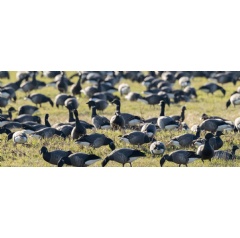Numbers of protected birds soar to new record after overhead power lines are removed on remote Essex island
National Trust rangers at Northey Island in Essex, with support from volunteers, have recorded record numbers of two protected bird species following the re-routing of the island’s power infrastructure.

Northey Island is the single largest block of saltmarsh in the Blackwater Estuary and is a haven for a huge variety of wildlife due to its peaceful location and unique biodiversity of habitats, and attracts many species of overwintering waterfowl and wading birds.
In January, the team recorded 3,875 dunlins (which are a red listed species on the Birds of Conservation Concern) on the island, beating the previous record of 3,510 recorded in 2015 – an increase of 10 per cent and representing 1.1 per cent of the total population which overwinters in the UK.
Northey Island is also a key overwintering site for dark-bellied brent geese (on the amber list for protection) and in January 1,710 geese were recorded on the island, the highest number for seven years.
These new records are especially important due to the sad decline of bird species in the UK, with 38 million birds being lost from our skies in the last 50 years.
David Mason, ranger for the National Trust at Northey Island said: “The increase in numbers is likely due to the re-routing of overhead power lines underground and the removal of poles which has opened up a large section of the island and created improved landing areas for the birds for feeding and resting during their annual migrations.
“Prior to this project, the geese avoided the entirety of one field containing powerlines as well as the majority of a second, and now that they have been removed the geese have been using all the fields on the island along with the saltmarsh areas. Winter is an important time for birds to build up their vital energy stores, and the island now provides an even better environment for them to do so.
“Additionally, a number of the telegraph poles will remain on the island, cut to a low level and with nesting boxes placed on top, which will provide a safe place for birds like oystercatchers to nest away from ground predators.”
As well as record numbers of dark-bellied brent geese and dunlins, the team have also seen increased numbers in other bird species, including curlews, avocets and lapwings, all of which are also at risk of decline.
The electricity poles were removed and the cables placed underground in preparation for a major milestone in managed realignment works on the island which seek to strengthen and improve its saltmarsh habitat.
As part of this, two sections of the sea wall will be lowered later this year to allow the sea to flood parts of the island, creating new saltmarsh. Other preparation work included creating new ponds and scrapes to provide freshwater feeding and resting sites for birds, as well as the relocation of a colony of water voles.
Daniel Leggett, Senior Project Manager for the National Trust, explains; “We’ve been working at Northey Island for many years to improve the saltmarsh habitat which is threatened by sea level rise and climate change impacts. Later this year we will remove two sections of the embankment to allow the sea to come through the wall and, over time create new saltmarsh. Once this happens, the area of the island where the overhead cables have been removed will become intertidal, meaning twice a day, at high tide, it will be covered by the sea, so this re-routing has been an important part of the preparations.
“Opening up the landing path has already made a big difference, and it’s great to see so many more birds using this part of the island for feeding and roosting. As we head towards the completion of the project, we hope we will continue to see increases in all wildlife across the island, but particularly those protected and at-risk species which need extra help.”
The bird counts have been carried out by volunteer Chris Tyas as part of the BTO (British Trust for Ornithology) Wetland Bird Survey, which monitors bird populations across the UK.
Chris, who has been carrying out bird surveys at Northey Island for more than 23 years, said: “Counting the birds on Northey Island is never easy, given the size and complexity of the saltmarsh areas, but it is a privilege as well as a challenge. Doing the surveys on the island are the highlight of my birding month and they’re never the same twice. I’ve had many highlights over the years, but the recent recording breaking numbers is a standout moment.”
The work to remove the electricity cables was made possible thanks to funding from the National Highways Environment and Well-Being Designated funds.
( Press Release Image: https://photos.webwire.com/prmedia/7/304655/304655-1.jpg )
WebWireID304655
This news content was configured by WebWire editorial staff. Linking is permitted.
News Release Distribution and Press Release Distribution Services Provided by WebWire.